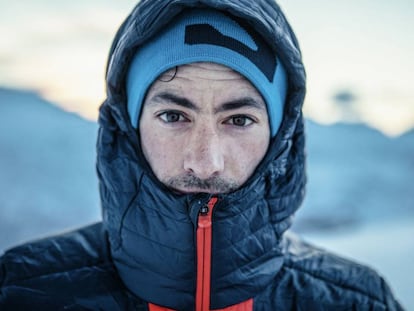Sarah MacNair-Landry, the explorer who grew up surrounded by dogs and snow
The 33-year-old Canadian, the daughter of two polar guides, is the youngest person to explore the two poles and documents climate change on her trips

If you don’t find Santa Claus in Lapland, the South Pole or the North Pole, you might find Sarah McNair-Landry. The 33-year-old Canadian is not an elf, but she lives among glaciers and the northern lights. Her spirit of survival and adventure seems right out of a video game script: she is the youngest person to reach both poles and, together with her brother Eric, she has revolutionized expeditions by kite surfing across Greenland and the Arctic. She always has a camera on her helmet to document the trips and the impact of climate change.
“We must inspire young people to go out, to get to know the planet and to take care of it. They need to get active. It’s the same with the cold, if you stay still you will freeze,” says the explorer. McNair lives in a mobile home made of recycled materials that she built with her boyfriend, Erik Boomer — also an adventurer and kayak expert — in Iqaluit, a corner of the icy and giant Baffin Island in Canada. That’s where she grew up, surrounded by dogs and snow, with no television or roads. Her two polar guide parents taught her to live with temperatures that were so cold they couldn’t be registered by thermometers, and to love the white, deserted landscapes.
You won’t find her in a Caribbean resort. Despite having crossed the Sahara on a camel and the Gobi on a kite buggy, her comfort zone is the cold. McNair-Landry runs the company Northwinds, which makes expeditions and documentaries in the coldest areas of the Earth. She is the first woman certified by the International Polar Guides Association as a Master Polar Guide, and is considered one of the world’s top adventurers by National Geographic. At the age of 17, she reached the North Pole with her family on a sleigh that the crossed fluorescent nights. At 19, a statue was waiting for her in the heart of the South Pole: Lenin. The Soviets erected it there after tearing up Antarctica with tractors.
She’s gone to many places where humans have never walked, but their presence is still felt. The Inuit have told her about the disappearing animals, thawing ice and cracks along ancient paths. With her brother, she traveled the legendary Northwest Passage, made up of more than 1,860 miles of ice sheets where the Atlantic and Pacific oceans meet. The crossing had not been completed since 1906. Along the way, they came up against an obstacle, and had to make a 340-mile detour. That day, another surprise was in store for them: a hungry polar bear.
The McNairs form the almost perfect team. The yard of their house was the steppe where they played as children imagining distant megacities. That day in the Northwest Passage, nature reminded them of its harshness: Eric defended himself against the bear with a shovel while his sister looked for a gun. Sarah had to choose between her brother and the animal. She shot into the air and the bear walked away. The terror marked them like a tattoo.
American activist Will Steger knows the team. They taught him how to kite surf. For an old-school explorer of maps and sleds, it was a revelation. “They have done almost everything. Their challenge is to find another great challenge,” he details.
Sarah McNair-Landry still relies on her dogs, but she makes the most of technology: GPS, recording equipment, drones. On GoogleEarth, she found two unknown rivers in Greenland. The discovery led to the documentary Into Twin Galaxies. At the beginning of the expedition, Sarah was going so fast that her kite went up into the air and fell like a stone. She broke her helmet and part of a vertebra. Her partner, who was accompanying her, begged her to return, but she continued. Boomer avoids using the word “stubborn” to describe her: he prefers character. She smiles when reminded of the experience. On her trips there is no shortage of determination — or chocolate, entire boxes of them.
National Geographic has been following her travels since 2007, and she also works on her projects, uncovering hidden stories as seen in Pour Ne Pas Perdre le Nord (So As Not to Lose the North), a short documentary that denounces the mountains of garbage that is building up in Arctic towns. She also supports art installations such as Gauge, where she shows the white walls that emerge from the water and are painted by artists. She uses renewable energy for her equipment and has brought back Inuit techniques for making kayaks with the Qajakkut Society. Social media has given her adventures visibility, but while some users are just after the perfect Instagram shot, her posts are about respecting the environment.
In 2019, she received the 21st Century Adventurer Award from the European Outdoor Film Tour, the largest exploration film event on the continent. The adrenaline of sneaking into new folds of the planet and sharing its beauty gives her hope for the future. One of her most symbolic adventures was to repeat her parents’ pioneering journey around Baffin Island, which is as large as Spain. It was four months of traveling through a lunar and silent world. Many expect their polar guide to be an older, bearded man, and are surprised to find themselves with the snow queen.
Sign up for our weekly newsletter to get more English-language news coverage from EL PAÍS USA Edition
Tu suscripción se está usando en otro dispositivo
¿Quieres añadir otro usuario a tu suscripción?
Si continúas leyendo en este dispositivo, no se podrá leer en el otro.
FlechaTu suscripción se está usando en otro dispositivo y solo puedes acceder a EL PAÍS desde un dispositivo a la vez.
Si quieres compartir tu cuenta, cambia tu suscripción a la modalidad Premium, así podrás añadir otro usuario. Cada uno accederá con su propia cuenta de email, lo que os permitirá personalizar vuestra experiencia en EL PAÍS.
¿Tienes una suscripción de empresa? Accede aquí para contratar más cuentas.
En el caso de no saber quién está usando tu cuenta, te recomendamos cambiar tu contraseña aquí.
Si decides continuar compartiendo tu cuenta, este mensaje se mostrará en tu dispositivo y en el de la otra persona que está usando tu cuenta de forma indefinida, afectando a tu experiencia de lectura. Puedes consultar aquí los términos y condiciones de la suscripción digital.
More information
Archived In
Últimas noticias
Most viewed
- Oona Chaplin: ‘I told James Cameron that I was living in a treehouse and starting a permaculture project with a friend’
- Sinaloa Cartel war is taking its toll on Los Chapitos
- Reinhard Genzel, Nobel laureate in physics: ‘One-minute videos will never give you the truth’
- Why the price of coffee has skyrocketed: from Brazilian plantations to specialty coffee houses
- Silver prices are going crazy: This is what’s fueling the rally










































